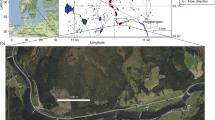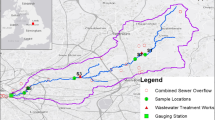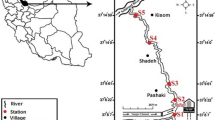Abstract
This article describes the development of a Nile Biotic Pollution Index (NBPI) for the River Nile in Egypt. Chemical data were collected from 30 locations along the Nile from Aswan to Cairo and 21 sites within the river delta, incorporating a range of conditions from unpolluted to grossly polluted. Seven chemical variables were used to calculate a Nile Chemical Pollution Index (NCPI) for each site. Biological data were collected primarily using Artificial Substrate Samplers (ASS). The UK developed, Biological Monitoring Working Party (BMWP) biotic index and the BMWP-ASPT were applied to the data. A Nile Biotic Pollution Index (NBPI) and the NBPI-ASPT were obtained by incorporating more of the Nile taxa. There were highly significant regressions (P < 0.001) for both the UK and the Nile Pollution Index scores with the NCPI for the whole river. The modification of the UK indices improved the Nile Indices increasing the number of taxa recorded from 29 to 43 and the total number of recorded taxon occurrences from 377 to 490. The Nile Indices provided better discrimination at both ends of the pollution spectrum. The NBPI-ASPT was best for the river as a whole, and particularly for the river from Aswan to Cairo. The NBPI was much better in the delta than from Aswan to Cairo. These differences in performance were attributed to the fact that the NBPI-ASPT excludes information on taxon diversity. In clean waters there was a wide range of NBPI score suggesting that the biodiversity of taxa is dependent on other aspects of habitat quality. Conversely in the polluted delta the high score of an individual taxon is critical for the NBPI-ASPT as it may have a distorting effect. As the NBPI-ASPT was the most consistent biotic index it is recommended as the regular biological assessment and regulatory tool for Egypt to meet the requirements of the Convention for Biodiversity.



Similar content being viewed by others

References
Abdel-Hamid, M. I. 1991. Phytoplankton and water quality of the River Nile in Egypt. Ph.D. Thesis, Botany Department, Faculty of Science, Mansoura University, Egypt. 95 pp.
Alba-Tercedor, J. & A. Sánchez-Ortega, 1988. Un método rápido y simple para evaluar la calidad biológica de las aguas correntes basado en el de Hellawell (1978). Limnetica 4: 51–56.
APHA, 1992. Standard Methods for the Examination of Water and Wastewater. American Public Health Association, Washington D.C.
Armitage, P. D., D. Moss, J. F. Wright & M. T. Furse, 1983. The performance of a new biological water quality score system based on macroinvertebrates over a wide range of unpolluted running water sites. Water Research 17: 333–347.
Bonada, N., C. Zamora-Munoz, M. Rieradevall & N. Prat, 2004. Ecological profiles of caddis fly larvae in Mediterranean streams: Implications for bioassessment methods. Evironmental Pollution 132: 509–521.
Balestrini, R., M. Cazzola & A. Buffagni, 2004. Characterising hydromorphological features of selected Italian rivers: A comparative application of environmental indices. Hydrobiologia 516: 365–379.
Chapman, D, (ed.), 1992. Water Quality Assessments. Chapman and Hall, London UK. 585 pp.
Chessman, B. C., 1995. Rapid assessment of rivers using macroinvertebrates: A procedure based on habitat-specific sampling, family level identification and a biotic index. Australian Journal of Ecology 20: 122–129.
Chessman, B. C., 2003. New sensitivity grades for Australian river macroinvertebrates. Marine and Freshwater Research 54: 95–103.
Chutter, F. M. & R. G. Noble, 1966. The reliability of methods of sampling stream invertebrates. Archives fur Hydrobiologie 62: 95–103.
Czerniawska-Kusza, I, 2005. Comparing modified biological monitoring working party score system and several biological indices based on macroinvertebrates for water-quality assessment. Limnologica 35: 169–176.
De Pauw, N. & S. Heylen, 2001. Biotic index for sediment quality assessment of watercourses in Flanders, Belgium. Aquatic Ecology 35: 121–133.
De Zwart, D., & R. C. Trivedi, 1994. Manual on Integrated Water Quality Evaluation. Report 802023003, National Institute of Public Health and Environmental Protection (RIVM) Bilthoven, The Netherlands.
Donohue, I., M. L. McGarrigle & P. Mills, 2006. Linking catchment characteristics and water chemistry with the ecological status of Irish rivers. Water Research 40: 91–98.
Environment Agency UK, 2002. The Water Framework Directive—Guiding Principles on the Technical Requirements. Environment Agency, Bristol, U.K., 84 pp.
Fishar, M. R., R. Thorne & W. P. Williams, 2006. Physico-chemical conditions and macroinvertebrate fauna in the River Nile from Aswan to Cairo. African Journal of Aquatic Science. 31: 247–259.
Fishar, M. R. & W. P. Williams, 2006. A feasibility study to monitor the macroinvertebrate diversity of the River Nile using three sampling methods. Hydrobiologia 556: 137–147.
Fouda, M., 2004. Overview on the programme of work on inland water biodiversity. In Fishar, M. R. & U. S. A. Khalifa (eds.), Status of Biodiversity of River Nile. Workshop held at British Council, Cairo, Egypt, 9 December 2003. 80 pp.
Gayraud, S., B. Statzner, P. Bady, A. Haybachp, F. Schöll, P. Usseglio-Polatera & M. Bacchi, 2003. Invertebrate traits for the biomonitoring of large European rivers: An initial assessment of alternative metrics. Freshwater Biology 48: 2045–2064.
Hellawell, J. M., 1986. The Biological Surveillance of Rivers; A Biological Monitoring Handbook. Water Research Centre, Stevenage. 333 pp.
Iliopoulou-Georgudaki, J., V. Kantzaris, P. Katharios, P. Kaspiris, Th. Georgiadis, & B. Montesantou, 2003. Application of different bioindicators for assessing water quality: a case study in the rivers Alfeios and Pineios (Peloponnisos, Greece). Ecological Indicators, 2: 345–360.
Illies, J. & L. Botosaneanu, 1963. Problemes et methodes de la classification et de la zonation ecologique des eaux courantes, considerees surtout du point de vue faunistique. Mitteilungen der Internationale Vereinigung für Limnologie 12: 1–57.
ISO-BMWP, 1979. Assessment of the Biological Quality of Rivers by a Macroinvertebrate Score. ISO/TC147/SC5/WG6/N5. International Standards Organisation, 18 pp.
Jiang, J.-G. & Y.-F. Shen, 2003. Development of a biotic index using the correlation of protozoan communities with chemical water quality. New Zealand Journal of Marine & Freshwater Research 37: 777–792.
Karr, J. R., 1981. Assessment of biotic integrity using fish communities. Fisheries 6: 21–27.
Kolkwitz, R. & M. Marsson, 1908. Ökologie der pflanzlichen Saprobien. Berichte der Deutschen Botanischen Gesellschaft, 26A: 505–519.
Kolkwitz, R. & M. Marsson, 1909. Ökologie der tierischen Saprobien. Beitrage zur Lehre von des biologischen Gevasserbeurteilung. Internationale Revue der Gesamten Hydrobiologie und Hydrographie 2: 125–152.
Meybeck, M, D. Chapman & R. Helmer, 1989. Global Freshwater Quality—A First Assessment. World Health Organisation and United Nations Environment Programme. Blackwells, Oxford, U.K., 306 pp.
Mustow, S. E., 2002. Biological monitoring of rivers in Thailand: Use and adaptation of the BMWP score. Hydrobiologia 479: 191–229.
Ogbeibu, A. & B. J. Oribhabor, 2002. Ecological impact of river impoundment using benthic macroinvertebrates as indicators. Water Research 36: 2427–2436.
Parr, L. B. & C. F. Mason, 2003. Long-term trends in water quality and their impact on macroinvertebrate assemblages in eutrophic lowland rivers. Water Research 37: 2969–2979.
Plafkin, J. L., M. T. Barbour, K. D. Porter, S. K. Gross, & R. M. Hughes, 1989. Rapid bioassessment protocols for use in streams and rivers: benthic macroinvertebrates and fish. EPA/444/4–89/001. Office of Water Regulations and Standards. U.S.Environmental Protection Agency, Washington, DC.
Rosenberg, D. M. & V. H. Resh (eds), 1992. Freshwater Biomonitoring and Benthic Macroinvertebrates. Chapman and Hall, New York, 488 pp.
Sandin, L. & D. Hering, 2004. Comparing macroinvertebrate indices to detect pollution across Europe: a contribution to the EC Water Framework Directive intercalibration. Hydrobiologia 516: 55–68.
Simpson, J. & R. H. Norris, 2000. Biological Assessment of water quality: development of AUSRIVAS models and outputs. In Wright, J. F., D. W. Sutcliffe & M. T. Furse (eds), RIVPACS and Similar Techniques for Assessing the Biological Quality of Freshwaters. Freshwater Biological Association and Environment Agency, Ambleside, Cumbria, U.K.: 125–142.
Sládacek, V., 1979. Continental systems for the assessment of river water quality. In James, A. & L. Evison (eds), Biological Indicators of Water Quality: Chap.3. John Wiley, Chichester, England.
Stiff, M. J., 1980. River Pollution Control. Ellis and Horwood, Chichester, UK, 423 pp.
Thorne, R. St. J. & W. P. Williams, 1997. The response of benthic macroinvertebrates in developing countries: A multimetric system of bioassessment. Freshwater Biology 37: 671–86. .
UNEP, 1999. Global Environmental Outlook-2000. UNEP’s Millenium Report on the Environment. Earthscan Publications Ltd, London, 398 pp.
Williams, W. D. & I. C. Campbell, 1987. The inland aquatic environment and its fauna. In Dyne, G. R. & D. W. Watson (eds), Fauna of Australia 1A, General Articles. AGPS, Canberra.
Wright, J. F., D. W. Sutcliffe & M. T. Furse, (eds), 1997. Assessing the biological quality of freshwaters—RIVPACS and other techniques. Freshwater Biological Association, Ambleside, Cumbria, UK, 373 pp.
Acknowledgements
We are most grateful to the British Council which funded the work through a British Council link agreement between Kings College London and the National Institute of Oceanography and Fisheries, Inland water and Aquaculture Branch, Cairo.
Author information
Authors and Affiliations
Corresponding author
Additional information
Handling editor: R. Norris
Rights and permissions
About this article
Cite this article
Fishar, M.R., Williams, W.P. The development of a Biotic Pollution Index for the River Nile in Egypt. Hydrobiologia 598, 17–34 (2008). https://doi.org/10.1007/s10750-007-9137-7
Received:
Revised:
Accepted:
Published:
Issue Date:
DOI: https://doi.org/10.1007/s10750-007-9137-7



